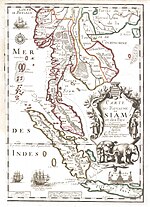
Back Srivijaya Afrikaans Srivichaya AN سريفيجايا Arabic Srivijaya AST Шривиджая Bashkir Srivijaya BCL Шрывіджая Byelorussian Sriwijaya BEW Шривиджая Bulgarian Kedatuan Sriwijaya BJN
Srivijaya Kadatuan Śrīvijaya | |||||||||
|---|---|---|---|---|---|---|---|---|---|
| c. 671–1025 | |||||||||
 The maximum extent of Srivijaya around the 8th to the 11th century with a series of Srivijayan expeditions and conquest | |||||||||
 Map of the expansion of the Srivijaya empire, beginning in Palembang in the 7th century, then extending to most of Sumatra, then expanding to Java, Riau Islands, Bangka Belitung, Singapore, Malay Peninsula (also known as: Kra Peninsula), Thailand, Cambodia, South Vietnam, Kalimantan, Sarawak, Brunei, Sabah, and ended as the Kingdom of Dharmasraya in Jambi in the 13th century. | |||||||||
| Capital | Palembang[1]: 295 | ||||||||
| Common languages | Old Malay and Sanskrit | ||||||||
| Religion | Buddhism Hinduism | ||||||||
| Government | Monarchy, mandala state | ||||||||
| Maharaja | |||||||||
• Circa 683 AD | Dapunta Hyang Sri Jayanasa | ||||||||
• Circa 775 | Dharmasetu | ||||||||
• Circa 792 | Samaratungga | ||||||||
• Circa 835 | Balaputra | ||||||||
• Circa 988 | Sri Cudamani Warmadewa | ||||||||
| History | |||||||||
• Dapunta Hyang's expedition and expansion (Kedukan Bukit inscription) | c. 671 | ||||||||
| 1025 | |||||||||
| Currency | Early Nusantara coins | ||||||||
| |||||||||
| History of Indonesia |
|---|
 |
| Timeline |
|
|
| History of Singapore |
|---|
 |
|
|
| History of Malaysia |
|---|
 |
|
|
| History of Thailand |
|---|
 |
|
|
Srivijaya (Indonesian: Sriwijaya),[2]: 131 also spelled Sri Vijaya,[3][4] was a Hindu-Buddhist thalassocratic[5] empire based on the island of Sumatra (in modern-day Indonesia) that influenced much of Southeast Asia.[6] Srivijaya was an important centre for the expansion of Buddhism from the 7th to 11th century AD. Srivijaya was the first polity to dominate much of western Maritime Southeast Asia. Due to its location, Srivijaya developed complex technology utilizing maritime resources. In addition, its economy became progressively reliant on the booming trade in the region, thus transforming it into a prestige goods-based economy.[7]
The earliest reference to it dates from the 7th century. A Tang dynasty Chinese monk, Yijing, wrote that he visited Srivijaya in 671 for six months.[8][9] The earliest known inscription in which the name Srivijaya appears also dates from the 7th century in the Kedukan Bukit inscription found near Palembang, Sumatra, dated 16 June 682.[10] Between the late 7th and early 11th century, Srivijaya rose to become a hegemon in Southeast Asia. It was involved in close interactions, often rivalries, with the neighbouring Mataram, Khom or Khmer Empire and Champa. Srivijaya's main foreign interest was nurturing lucrative trade agreements with China which lasted from the Tang to the Song dynasty. Srivijaya had religious, cultural and trade links with the Buddhist Pala of Bengal, as well as with the Islamic Caliphate in the Middle East.
Srivijaya is widely recognized as a powerful maritime kingdom in Southeast Asia. New research shows that while it had significant land-based elements, Srivijaya leveraged its maritime fleet not only for logistical support but also as a primary tool to project power across strategic waterways, such as the Strait of Malacca. In response to the ever-changing dynamics of Asia’s maritime economy, the kingdom developed sophisticated naval strategies to maintain its position as a regional trade hub. These strategies involved regulating trade routes and attracting merchant ships to their ports through strict control. As threats grew, Srivijaya’s fleet also transformed into an effective offensive force, used to protect trade interests while ensuring their dominance in the region.[11][12]
The kingdom may have disintegrated after 1025 CE following several major raids launched by the Chola Empire upon their ports.[13]: 110 After Srivijaya fell, it was largely forgotten. It was not until 1918 that French historian George Cœdès, of the French School of the Far East, formally postulated its existence.[14]
- ^ Cite error: The named reference
:02was invoked but never defined (see the help page). - ^ Cite error: The named reference
Coedeswas invoked but never defined (see the help page). - ^ Rausa-Gomez, Lourdes (20 January 1967). "Sri Vijaya and Madjapahit". Philippine Studies. 15 (1): 63–107. JSTOR 42720174.
- ^ Sastri, K. A. Nilakanta (20 January 2024). "Śrī Vijaya". Bulletin de l'École Française d'Extrême-Orient. 40 (2): 239–313. JSTOR 43733093.
- ^ Cite error: The named reference
Kulkewas invoked but never defined (see the help page). - ^ Munoz, Paul Michel (2006). Early Kingdoms of the Indonesian Archipelago and the Malay Peninsula. Singapore: Editions Didier Millet. p. 171. ISBN 981-4155-67-5.
- ^ Laet, Sigfried J. de; Herrmann, Joachim (1994). History of Humanity. Routledge.
- ^ Munoz. Early Kingdoms. p. 122.
- ^ Zain, Sabri. "Sejarah Melayu, Buddhist Empires".
- ^ Peter Bellwood; James J. Fox; Darrell Tryon (1995). Bellwood, Peter; Fox, James J.; Tryon, Darrell (eds.). The Austronesians: Historical and Comparative Perspectives. doi:10.22459/A.09.2006. ISBN 978-0-7315-2132-6.
- ^ Thwin, Maitrii Aung (ed.). "Journal of Southeast Asian Studies | Cambridge Core". Retrieved 13 December 2024.
- ^ "SRIVIJAYAN CIVILIZATION : The Awakening of a Maritime Kingdom" (PDF). Repositori Kemdikbud. Retrieved 13 December 2024.
- ^ Cite error: The named reference
:6was invoked but never defined (see the help page). - ^ Cite error: The named reference
MUNOZ 117was invoked but never defined (see the help page).